“The Heart of the Fish” – this is how our tramping/camping trip to Te Urewera and Lake Tarawera was described by Sarah’s colleague in Maori class. The area, an hour or so east of Rotorua and inland of Whakatane is a Maori hinterland. We were keen to explore.
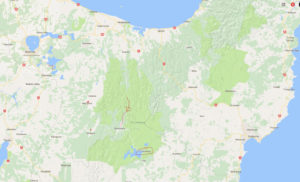
Piling a combination of tramping gear, camping stuff and vegetables at risk of going off into the car I head off to get Sarah. We load up and drive over the Rimutakas. The rain is persistent and consistent. Waterfalls cascade where they shouldn’t; we hear later that a slip closed the road behind us.
Our first stop is Masterton, where Sarah’s Dad surprises us with a Roast Pork lunch. It is delicious. We head on mid-afternoon and reach Wairoa at dusk. A downtrodden township, it is still one of the larger centres in the Hawke’s Bay; we find the grocery store with most workers idling about the entrance. It is 5 minutes to closing, at 7pm. We hustle through plugging the gaps in our combined food. I am still unsure about what we’re doing; are we operating out of the car or going tramping?
A kindly worker waits to lock the gates behind us – then we’re out of Wairoa and into the hills. It is pitch darkness, and the rain patters on. As we weave along gorges on the way to Lake Waikaremoana, rocks, branches and trees litter our path. Sarah drives now and I strain my eyes ahead, on the look out for boulders too large for the wee car.
At one point, our headlights catch a small rock, jumping across the road. What!?
Then another. I recognize distinct frog legs. I have never seen frogs in the wild in New Zealand, let alone jumping about infront of the car; it’s a different place up north.
The native bush is dense, broken only by small gravel roads at intervals. We stop and reposition the car, using the headlights to read the signs; no campsite. On we travel. Eventually we make it to the lake, and find the place locked up for the night. A rap on the after-hours door sees a soft-spoken teen showing us to a cabin; we decide against pitching the tent in this weather.
We make nachos and huddle about the heater. It’s a false start to our adventure but that’s OK; the trip begins tomorrow.

“Another day in paradise” an old man says in the morning, over his eggs in the camp kitchen. He and some others look to have been here some time, spending it with old friends and fishing on the lake. Lake Waikaremoana is one of the North Island’s beauty spots, and the tramping route around it is the north’s only Great Walk. We have arrived at a time of transition; it only recently has been returned to Tuhoe (the local Maori iwi [tribe]) ownership after the government stole it during the Land Wars.
The Tuhoe people have a special reputation in New Zealand. Their position in remote, mountainous and not overly valuable (to settlers) land allowed them some ability to be isolationist from European settlement. They refused the building of roads and did their own thing for a long time, until they sheltered Te Kooti (a united Maori leader) during the land wars. In retribution the government attacked Tuhoe and confiscated their lands. Unlike many other iwi they never signed the Treaty of Waitangi, they always have been consistent in their independence. In recent years, our very own domestic terrorism excitement occurred in Te Urawera (jesus it was 10 years ago!) At any rate, I find any lack of welcome to be only preconceptions I brought with me – everyone we meet is friendly, open, helpful and welcoming. I do no justice to Tuhoe, have a read yourself.
We’re interested to see how the management of the area’s tramping and tourism differs when under Tuhoe stewardship as opposed to the Department of Conservation. We suspect a more localized system will develop, but at this precise time it is a bit inconvenient, – no bugger stocks the right Topographical maps! We shuttle between the Visitor Centre and the campsite shop, gathering what information we can.
Sarah had warned me about visitor centre advice. ‘They are very risk adverse, don’t know your expertise and always discourage intrepid travel.’ And true to form, the lady suggests we do a common route into the hills above Waikaremoana. A well-frequented path in summer, with 18person huts and a bunch of well-spaced things to look at. I am easily swayed and sold, but Sarah is not. ‘Well, as long as you have a PLB” (personal locator beacon) she says.
‘We don’t have one’ Sarah replies. There is a silence.
We are going to Tewhiwhi hut, a mid-sized hut in a clearing next to the head of the Whakatane river. To get there we drive on to Ruatahuna, a tiny township west of Waikaremoana. We drive north to a roadend by an isolated Marae. There’s an eclectic settlement, with ramshackle huts joined together, 60s houses and modern sheds. In the spitting rain we don our tramping gear and head to the farmgate leading north up the valley.
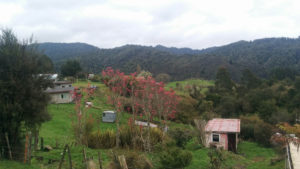
A sign states ‘for secure parking, call:’. It’s blank. I double-back and pack my SLR with both lenses; my knees don’t thank me for the extra weight but my peace of mind does. It’s not the most financially affluent of areas and I am a paranoid wally. Soon we are trudging through the farmland; Sarah far ahead, me toddling along, taking photos and wees.

The farm management seems a bit different up there, with newborn lambs all over the access way. One lamb is following a ewe with two of her own lambs, and a wounded foot. We accidentally separate the parties with our presence, and the stupid sheep shepherd themselves a kilometer along the road ahead of us. ‘That’s life’ Sarah tells me – ‘exhibit A’ – pointing her boot to the rotting corpse of a lamb. There are corpses littered all over; not just lambs but ewes too. There’s a dead sheep at the head of a waterway; another waterway has the arches or ribs protruding with the wretched stench of death. When we return nothing is different – the lack of management surprises me, from an ethical and financial perspective you’d expect someone to take a look once in a while. Maybe I am naive!
We trudge on and eventually make it to the bush line. The land is compacted into a very clear track. It is well tended and cut back, and the hooves of stock show we’re not the only ones who go this way.

There are patches of beautiful bush, massive trees from before our love of lumber. Between the bush are fields of free-flowing pasture where cows, deer and horses keep the grass down. As the hours plod away, it’s strange to come across these signs of agriculture.

We cross many streams, all feeding to push the Whakatane river higher. Before one we come across a small camp, a fire set in the bushes. It’s a ramshackle spot, with plastic for walls, but somebodies home; a different life out here.
We arrive at a river – it is large, but split into two and we are confident to cross. Sarah teaches me how to do proper river crossings, weaving our arms behind each others’ packs. It mightn’t have been necessary with two, on that river, but they are good skills to learn. Water is often taken too lightly, at people’s peril.
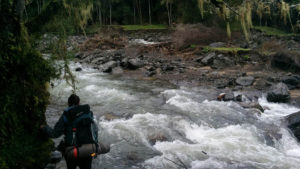
We stop for a snack, and I reach for the camera; it’s gone. Lost from my pocket somewhere between here and lunch. ‘We can go back and look for it’ Sarah suggests – I decide to leave it for our return and press on. I hadn’t taken a photo for a while; the odds of us spotting it are low and we haven’t the daylight.
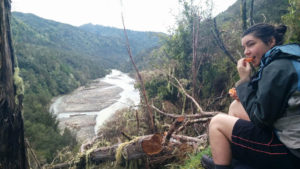
So press on we do. We arrive at a wire bridge; the final large crossing, the one we worried about. But the wire bridge is still there, albiet a bit low on tension. Sarah is first, and is making progress. I take some photos with the cellphone, but then there’s trouble. The tension is so low, she can reach the guide wires rather than lean on them, and her bed roll has got stuck on one side of a the V brackets. She’s stuck, with no hands to help her. Eventually, some fairly harrowing effort later, she figures out a way to get the back through and makes it over. I remove my bedroll and strap it to the side of my back instead; I wouldn’t handle it as well as she did! I shuffle across and it’s fine. We are all smiles on the other side; adrenaline leaving our systems.

An old horse-drawn plough leans against new(ish) growth Manuka trees; the old ruts we spot here and there might be remnants of gardens, or old roads; it’s hard to know, but it’s certain that at some point this valley was further-utilised.
Soon we arrive, to a large open plain, with the fine Tawhiwhi Hut plopped in the middle. A well laid out hut, with 13 bunks, an open fire, a 180degree deck and a dead young tui inside. The volume of bird shit everywhere suggests it came down the chimney then starved to death, poor thing.
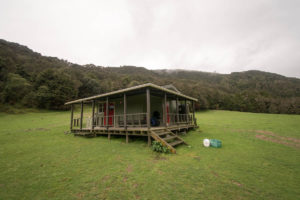
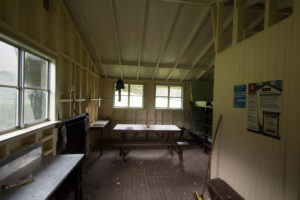
We hang our socks and enjoy cups of tea. Sarah reads a Women’s Day; the only reading material at the hut – go figure! The crossword wasn’t even done! As dusk descends, so too do horses, grazing around the cabin. They are relatively unphased by our presence.
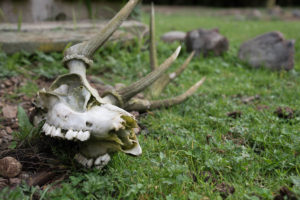
Sarah has a wee kip and I take photos for Virtual Reality modelling.
Dinner is a concoction from Sarah’s friends Earthquake preparedness kit; they’d just left New Zealand and donated their rations. So we had an Alfredo pasta mix, with Tinned Corned Beef. Yes it does look like cat food, but once it was cooked it was perfectly reasonable (just don’t look at it too closely).
I pop out for a little stroll, finding various carcasses and old earthworks around the place. The history of the area fascinates me, the tracks are so well-worn and old – maybe the stock have used them ever since stock arrived in the country.
I return to the hut to find Sarah asleep; it’s 7:30pm. There’s naut to do, so I go to sleep too. Someone’s drawn a swastika on the underside of the bunk.
Sarah has a poor sleep – she was worried about our return journey. Though it didn’t rain all night, it was forecast. The Urawera’s are known for rain and if that larger stream rises, our return may be dangerous or impossible. Our ‘extra food’ comprises only plain porridge, so it is hoped we don’t have to wait it out.
We pack up early, bothering the 13 horses who surround the cabin nibbling the grass in the morning.
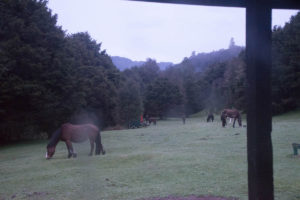
I tell Sarah something must have died near the water tank; it smells awful. ‘I hope there’s nothing in it’ she says; this has me worried. It does seem to stink only when the tap has run; I figured it was the runoff disturbing some corpse below, not pouring fetid water of death. At any rate, we only drunk tea the night prior and the guts are fine – we take some water of death with us, but we are loathe to drink any.

Our return is much like yesterday, but without the discovery. We’ve been this way before. The lost camera hides from us; I wish it the best for its new life in the Uraweras.
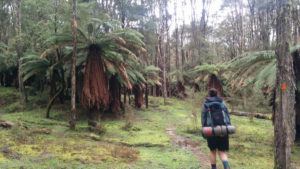
When we arrive at the farmland, we stop for a bite to eat. ‘Shall we just eat a chunk of salami?’ Sarah offers. I shout ‘yes!’ such is my surprise enthusiasm. I seem to have less moderation when tired.
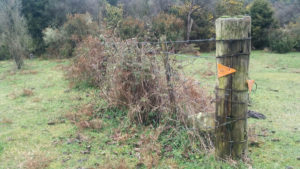
The farmland road of bones seems longer on the way back, but unlike the corpses underfoot we do make it out. The car is in one piece too.
We leave Ruatahuna and follow the tortured road to a rest stop opposite a camp site. A digger is moving sod; a legion of diggers and trucks have been moving sod since April, when an enormous storm swept through. The roads are a mess. The stream beside it is worse, dredged along it’s whole length to open it up again.
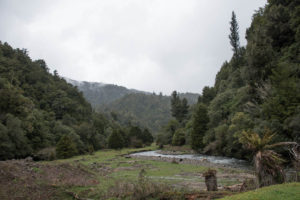
We had intended to drive to the next hut, off a roadside outside Ngaputahi. We started along, but a sign warned us it was 4×4 access only. I wasn’t comfortable taking the Jazz out there, so Sarah was a sport and did a 100 point turn to take us out again. Unfortunately plan B was another four hour tramp to Okui hut, further up the road. I took some time to come around to this plan. So long, in fact, that we ended up leaving the Uraweras and arriving in Murupara, a down-on-its luck little township. The road end to the Okui tracks were so carved up by earthmovers we didn’t see it.
We order some fish and chips and while they cook, look about the township. It’s a cute little 60s affair, wee shops surrounding a central square of gardens and parking. These days 50% of the shops are empty, and the rest of them are either artist’s shop-front-window galleries, or services pitched to society’s struggling. A police office neighbours onto a parole office, opposite WINZ and the credit money shop. A burnt out shop depresses the entrance to the library. It’s sad. The town grew on the timber trade, but with that wilting and dying (we send most wood to be processed overseas now, if New Zealander’s even own the forestry) the town has slumped too.
We pop in to the DOC visitor centre outside town, and they suggest the Waterfall Campsite for the night. With promise of a cooking shelter if it’s raining we head back into the Urawera’s. Eyes peeled for the Okui road end again, we miss it entirely and arrive at the Waterfall campsite. It is beautiful and deserted.
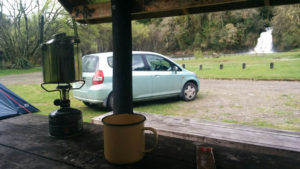
We pitch the tent, have a tea, and Sarah hit’s the hay. I loiter about and read the graffiti in the cookhouse. An aspiring comedian has written ‘loves cock’ in vivid after every other kids’ name on the walls. They seem to have created their own gang, called the Face Biters. ‘Mongrel Mob’ is etched in charcoal from the fire, in a childs handwriting. It’s rather sad, I hope most kids have more to aspire to.
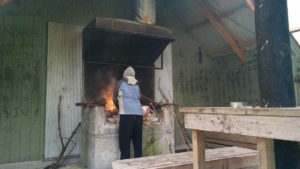
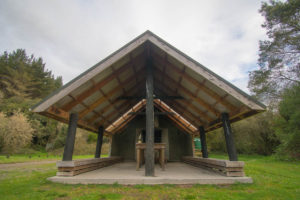
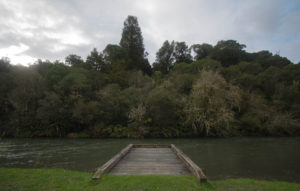
I awake at 10:30 to the sound of tires crunching. My mind churns, my ears straining against the waterfall to hear what’s going on outside the tent. Are we going to be murdered by a gang? Are we going to be robbed? My mind swirls, it is awful. I play worse and worse situations in my head. I hear all manner of sounds within the churning sound of the waterfall. Such a delight earlier, I curse it now. Eventually I reach such a state of anxiety, it releases. ‘What will be will be’ my mind decides, and I drift back to sleep.
I awake unmurdered to find us alone in the campsite. We have coffee and porridge, pack up and drive on to Rotorua – destination Lake Tarawera.

Leave a Reply